Britain took its first tentative steps towards ice enlightenment at the turn of the millennium. In an echo of how ice had reinvigorated American cocktail culture in the early 20th century, leading to the creation of whole categories of drinks – juleps, smashes, cobblers – British marketing teams began to realise abundant ice's potential as a means of altering customers' perceptions about a product, and ice emerged as the central component of several hugely popular campaigns.
在千禧年之交,英國試探性地邁出了冰啟蒙的第一步。這與20世紀(jì)初冰如何復(fù)興美國雞尾酒文化如出一轍,各種飲料叢生——朱利酒、碎酒、補(bǔ)鞋酒——英國的營銷團(tuán)隊(duì)開始意識到,冰塊可以作為一種改變顧客對產(chǎn)品看法的手段且潛力巨大,至此冰塊成為了幾個(gè)廣受歡迎的方案的主力。
The first was Magners, the Irish cider brand that would come to dominate pub beer gardens during the World Cup summer of 2006. The accompanying advertising campaign would be credited by trade publications for almost single-handedly revitalising the ailing cider industry, rehabilitating its public perception as a "cheap intoxicant" and transforming it, as described in these pages, into "the new chardonnay".
第一個(gè)是麥格納斯,這一愛爾蘭蘋果酒品牌在2006年世界杯期間稱霸了酒吧的啤酒花園。行業(yè)刊物將隨之而來的廣告宣傳活動(dòng)譽(yù)為幾乎是單槍匹馬振興了瀕臨破產(chǎn)的蘋果酒行業(yè),恢復(fù)了公眾對蘋果酒“廉價(jià)買醉”的看法,并將其描述為“新的霞多麗白葡萄酒”。
The secret – as anyone unable to forget the clink-and-hiss sound effect that concluded Magners's sun-dappled TV spot will attest – was ice, and lots of it. The campaign struck a chord with consumers, and other brands raced to introduce their own ice-led offerings. In 2010, seeking to find an audience for its new crushed ice product, The Ice Co twinned with Bacardi Limited on a series of campaigns featuring brand names such as Bombay Sapphire, Martini and Bacardi on its ice bags, accompanied by a photo of an appealing-looking cocktail heavy on the ice – an education drive intended to teach consumers how to make the perfect cocktail to serve at home.
秘密是冰,而且是大量的冰——任何人都無法忘記麥格納斯斑駁的電視廣告中的叮當(dāng)聲和嘶嘶聲效。這一營銷活動(dòng)引起了消費(fèi)者的共鳴,其他品牌紛紛推出了自己的冰主導(dǎo)產(chǎn)品。2010年,為了為其新碎冰產(chǎn)品尋找受眾,The Ice Co與Bacardi Limited合作推出了一系列以孟買藍(lán)寶石等品牌為主題的活動(dòng),冰袋上印有馬提尼和巴卡第,并配了一張看起來很吸引人的冰雞尾酒的照片,這是一項(xiàng)教學(xué)活動(dòng),旨在教會(huì)消費(fèi)者如何調(diào)制適合自己在家享用的完美雞尾酒。

In 2011, Moet Hennessey attempted to replicate the Magners magic with Moet Ice Imperial, "the first champagne specifically designed to be served over ice". The ice-cubes-in-wine trend would reach its logical conclusion five years later with the popularisation of frose, essentially a rose wine-flavoured Slush Puppy. More recently, the staggering success of the Aperol Spritz has been explained by its Instagrammable bright orange colour and sophisticated aperitivo-culture heritage. But those investigating the trend might also note that unlike one of its ingredients – that millennials' favourite, prosecco – the spritz is always served on the rocks.
2011年,酩悅軒尼詩試圖用酩悅冰帝國來復(fù)制麥格納斯的魔力,“這是第一款專門設(shè)計(jì)的加冰香檳。”5年后,隨著冰桃紅雞尾酒的流行,在酒里放冰塊的趨勢有了一個(gè)合理的定義,其本質(zhì)上就是一種玫瑰酒口味的Slush Puppy(飲料名)。最近,阿佩羅開胃雞尾酒的巨大成功要?dú)w功于其值得上傳到Ins的亮橙色和復(fù)雜的開胃酒文化傳統(tǒng)。但那些研究這一趨勢的人可能也會(huì)注意到,與它的成分之一——千禧一代的最愛,普羅塞克酒——不同的是,阿佩羅開胃雞尾酒總是加冰塊的。
All these campaigns raised the public's expectations of drinking outside the home. Pubs that might once have doled out a miserly single cube now had to shovel pint glasses full to the brim; the distinctive sound of ice chinking on glassware or rattling in plastic party cups became the soundtrack of the British summer. Within The Ice Co, they call it "the clink effect": the power of ice to stir a host of associations within the consumer, all of them uplifting and positive.
所有這些營銷活動(dòng)都提高了公眾對外出飲酒的期望。酒吧以前可能只會(huì)提供一小塊冰塊,而現(xiàn)在不得不品脫玻璃杯塞得滿滿的。冰塊在玻璃器皿上或在塑料派對杯子里叮當(dāng)作響的獨(dú)特聲音成為了英國夏天的音樂。The Ice Co內(nèi)部稱之為"叮當(dāng)效應(yīng)”:冰塊的力量激起了消費(fèi)者的一系列聯(lián)想,所有這些聯(lián)想都是令人振奮的、積極的。












